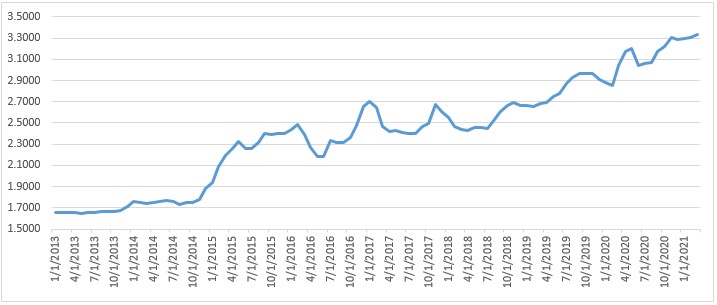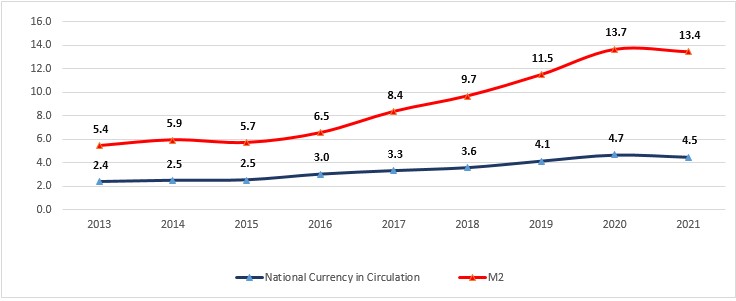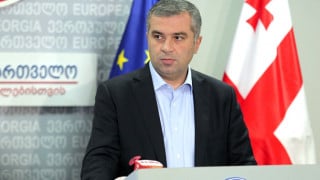Davit Bakradze: “The Georgian Dream inherited USD at 1.6 and it is now up at 3.4.”
Verdict: FactCheck concludes that Davit Bakradze’s statement is MOSTLY TRUE.
Resume:
The GEL exchange rate started falling drastically from November 2014 and depreciated by approximately 87% whilst the depreciation amounts to nearly 100% as compared to 2012. GEL has a floating exchange rate and its equilibrium at a certain level is stipulated by the supply and the demand proportion between GEL and USD on the currency market. Naturally, numerous factors simultaneously affect supply and demand and these factors can notionally be divided into a country’s internal and external factors. Given political motivations, the GEL exchange rate is frequently linked with either internal factors or external factors separately with the aim of show half-truths. It is an objective reality, however, that the region suffered from many crises in 2013-2020, including the global pandemic. In 2013-2021, the currencies of Georgia’s immediate neighbour countries have more or less depreciated vis-à-vis USD. As compared to 2012, TRY depreciated by 376%, RUB by 151%, AMD by 32% and AZM by 117%.
On the other hand, of note is that certain actions of the Government of Georgia or its inactions as well as a myriad of mistakes also negatively affected the GEL exchange rate. For instance, we can name the tightening of the visa policy, the banning of selling land to foreigners, demonstrating an inconsistent policy towards investors, suspending/delaying infrastructural projects and unequal budget spending, etc. GEL also sharply depreciated after the so-called Gavrilov Crisis which, alongside the opposition, even the members of the government believe was a grave mistake. Of additional note is that the national currency in circulation increased by 90% and broad money (M2) by 148% as compared to 2013.
The context of Davit Bakradze’s statement is unquestionably a criticism against the government. The part of the statement where he speaks about the sharp depreciation of GEL is true. Many different explanations can be offered vis-à-vis the causes behind the depreciation which has taken place as a result of both a wrong government policy as well as objective circumstances which have nothing to do the with authorities. Therefore, FactCheck concludes that Mr Bakradze’s statement is MOSTLY TRUE.
Analysis
The former chairperson of the European Georgia – Movement for Freedom political party, Davit Bakradze, stated: “The Georgian Dream inherited the USD at 1.6 and now it is up at 3.4.”
GEL depreciation vis-à-vis USD and EUR has been one of the most problematic issues of Georgia in the last years. GEL started to fall drastically from November 2014 and depreciated by approximately 87% and as compared to 2012 where the depreciation amounts to nearly 100%.
Graph 1: GEL to USD Average Monthly Exchange Rate in 2013-2021

Source: National Bank of Georgia
GEL has a floating exchange rate and its equilibrium at certain level is stipulated by the supply and the demand proportion between GEL and USD on the currency market. Naturally, numerous factors simultaneously affect supply and demand and these factors can notionally be divided into a country’s internal and external factors. Given political motivations, the GEL exchange rate is frequently linked with either internal factors or external factors separately with the aim of show half-truths. Analysing the full picture is needed in order to ward off speculations. External factors have been troublesome both at the regional and the international levels. Of note is the global appreciation of USD which was followed by the depreciation of almost all currencies vis-à-vis the American dollar.
In 2013-2021, the currencies of Georgia’s immediate neighbour countries have more or less depreciated vis-à-vis USD. As compared to 2012, TRY depreciated by 376%, RUB by 151%, AMD by 32% and AZM by 117%. As a result of the sharp fall of oil prices, oil exporter countries have become particularly vulnerable. Georgia is not an oil exporting country in contrast with its large economic partners. However, hiccoughs in their economies and their currency stability are also reflected here. In addition, the aforementioned period has been full of quite difficult political and economic crises. Of mention are the attempted coup d’état in Turkey and Ankara’s further strained relations with the West, the Russia-Ukraine crisis, the Syria crisis and the Armenia-Azerbaijan conflict, etc. The ongoing global pandemic has been particularly damaging. In particular, Georgian tourism revenues which accounted for USD 3 billion in the previous months have dropped to near zero. Further, there is decreased currency income from investments and an increased economic uncertainty as well as the emergence of numerous micro or macro crises which naturally come together to have a negative impact on the country’s economic conjuncture and the strength of the national currency. The GEL depreciation was inevitable in these circumstances because Georgia’s trade deficit would otherwise have been widened [1] even further (since the country’s export would have become more expensive and its imports cheaper).
On the other hand, of note is that certain actions of the Government of Georgia or its inactions as well as a myriad of mistakes also negatively affected the GEL exchange rate. For instance, we can name the tightening of the visa policy, the banning of selling land to foreigners, demonstrating an inconsistent policy towards investors, suspending/delaying infrastructural projects and unequal budget spending, etc. GEL also sharply depreciated after the so-called Gavrilov Crisis, which, alongside the opposition, even the members of the government believe was a grave mistake.
In addition, an analysis of monetary aggregates in terms of supply is interesting whilst discussing the GEL exchange rate.
Graph 2: Changes in Monetary Aggregates in 2013-2021, GEL Billion

Source: National Bank of Georgia
The M2 monetary aggregate (broad money without foreign currency deposits) is the total sum of narrow money and the savings and time deposits of resident entrepreneurs and the household sector in the banking sector denominated in the national currency excluding the deposits of banks and the government sector. As compared to 2013, the national currency in circulation increased by 90% from GEL 2.4 billion to GEL 4.5 billion whilst broad money (M2) increased by 148% from GEL 5.4 billion to GEL 13.4 billion.
[1] The factor of USD as a dominant currency largely impedes the functioning of this counter-balancing mechanism.








